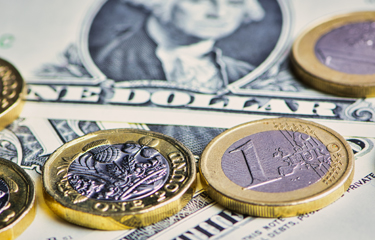One U.S. dollar is worth nearly the same as a euro, the currency of the European Union, marking the first time since 2002 the euro has not been worth more.
The impact of Russia’s invasion of Ukraine, which has triggered higher oil and gas prices across Europe and globally, has combined with higher inflation and a souring global economy to weaken the euro’s value. And the U.S. dollar’s reputation as a safe haven currency has buoyed its value, despite the U.S. facing many of the same problems as Europe, though the U.S. Federal Reserve’s aggressive push to raise interest rates has made the dollar more attractive to investors compared to the euro, according to Bloomberg. The U.S. central bank has already raised interest rates three times in 2022 and is planning up to four additional hikes to bring inflation under control. The European Central Bank also is expected to raise rates, but is planning a slower rate of increase.
The last time the U.S. dollar on par with the euro in value terms was December 2002, less than three years after the creation of the currency in 1999. The euro hit its peak value against the dollar in 2008, when one euro was worth USD 1.60. Its value has fallen by 16 percent against the dollar over the last 12 months, and 12 percent in 2022.
The stronger dollar will help American consumers as the price of commodities become more affordable, potentially helping to ease inflation. And European exporters to the U.S. may be helped by the fact that their goods are now less expensive to U.S. buyers. But U.S. seafood exporters will be hurt by the higher value of the dollar in their own efforts to sell their wares abroad.
Rapidly rising inflation and supply-chain bottlenecks have made commodities more expensive recently, but a stronger dollar could help contain prices, according to Infrastructure Capital Management CEO Jay Hatfield.
“The strong dollar drives the prices of global commodities lower, as most commodities are priced in dollars,” Hatfield said. “We anticipate that inflation will start dropping substantially in the fall as commodity prices are reflected in price indices.”
Alex Kuptsikevich, senior market analyst at foreign currency trader FxPro, told the Washington Post the weaker euro is a sign of slower economic growth for Europe.
“It is worth expecting that Europe will no longer get away with soft market reassurances and modest actions, so the pressure on the single currency may persist for the foreseeable future,” Kuptsikevich said.
The shifting exchange rates will create a complicated web of winners and losers, but with higher inflation, Europe probably faces a bleaker economic future.
“It’s becoming increasingly clear that the eurozone is heading into recession, even as financial conditions have tightened more than in the U.S. or Japan,” Institute of International Finance Chief Economist Robin Brooks said on Twitter.
Photo courtesy of C. Nass/Shutterstock







